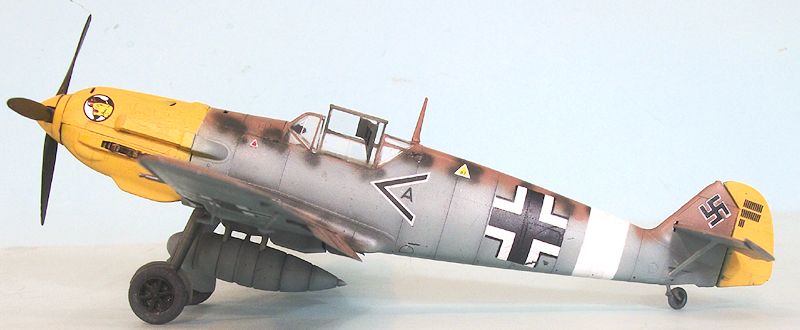
Eduard 1/48 Bf-109E-7/trop
| KIT #: | 8264 |
| PRICE: | $ |
| DECALS: | Five options |
| REVIEWER: | Tom Cleaver |
| NOTES: | Profipak |

| HISTORY |
JG 27 In The North African Campaign:
JG 27 was formed on October 1, 1939.
The insignia of I/JG 27, the lion over the map of Africa, memorialized
the birth of the Gruppenkommandeur, Hauptmann Helmut Riegel, in
German Southwest Africa.

| THE KIT |
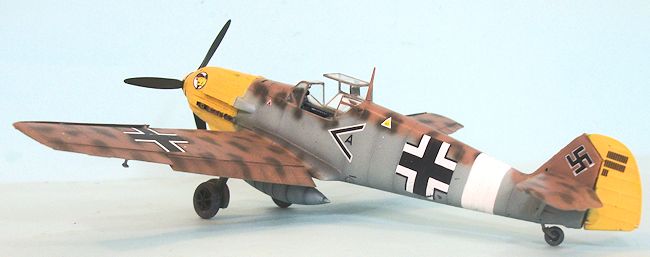 Eduard has
essentially scaled down their 1/32 Bf-109E series to 1/48 for these kits.
The smaller kits have all of the strengths and most of the weaknesses of
the earlier, larger kits, without the problem of the incorrect canopies that
hampered the early-release 1/32 Bf-109E-4 kit.
The smaller kits have very petite surface detail with rivet detail as the
larger kits, and the Profipack version provides extensive photoetch detail, both
for the cockpit and the rest of the aiframe, with good photoetch instrument
panels and seat belts, and radiator details.
Decals are provided in the Trop version for five Bf-109E-4 and E-7
aircraft flown by pilots of JG 27.
Eduard has
essentially scaled down their 1/32 Bf-109E series to 1/48 for these kits.
The smaller kits have all of the strengths and most of the weaknesses of
the earlier, larger kits, without the problem of the incorrect canopies that
hampered the early-release 1/32 Bf-109E-4 kit.
The smaller kits have very petite surface detail with rivet detail as the
larger kits, and the Profipack version provides extensive photoetch detail, both
for the cockpit and the rest of the aiframe, with good photoetch instrument
panels and seat belts, and radiator details.
Decals are provided in the Trop version for five Bf-109E-4 and E-7
aircraft flown by pilots of JG 27.
| CONSTRUCTION |
The first thing I noticed about the kit was that it had the problem I had first
seen in the larger kits, i.e., leading edge slats that were too large in chord.
I assembled the wing and then filled in the area of the outer wing that
is under the slat. On the real
airplane, there is no ďcut outĒ like this, so I smoothed the area after the
putty dried, giving it an airfoil shape.
I then sliced off a 1/32-inch wide strip from the rear edge of the slat,
to get it the correct dimension. I
rescribed rivet detail with my pounce wheel after
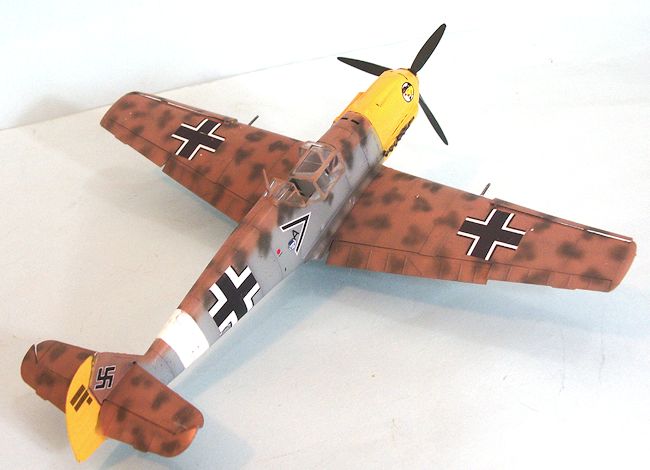 rescribing
panel lines that had been lost sanding out the outer wing leading edge area.
rescribing
panel lines that had been lost sanding out the outer wing leading edge area.
The biggest problem I had with the assembly process was getting the
fershlugginah exhaust stubs to fit inside their cover.
I had to sand them down to get them to slide in, and even then they
really didnít fit, thought from a foot away itís not that noticeable.
Eduard could have saved everyone a lot of trouble and made one-piece
exhausts like Hasegawa did and no one would notice once everything was together.
Eduard has a habit of over-thinking their kit design and adding in
complexity for the sake of complexity, to my mind; itís my one big gripe about
most of their kits, though these 109s are nowhere near as fiddly as the 1/48
Bf-110s or the Fw-190s.
| COLORS & MARKINGS |
I painted the white stripe area and masked that, painted the nose white and then yellow. I took thinned Xtracrylix Gelb 04 and brush-painted it over the airbrushed Tamiya yellow, to give a sensation that this area had been brush painted as it was on the real airplane. That was masked off and then I pre-shaded the model. I applied the RLM 78/79/80 desert camouflage using Xtracrylix paints applied freehand with my Paasche-H.
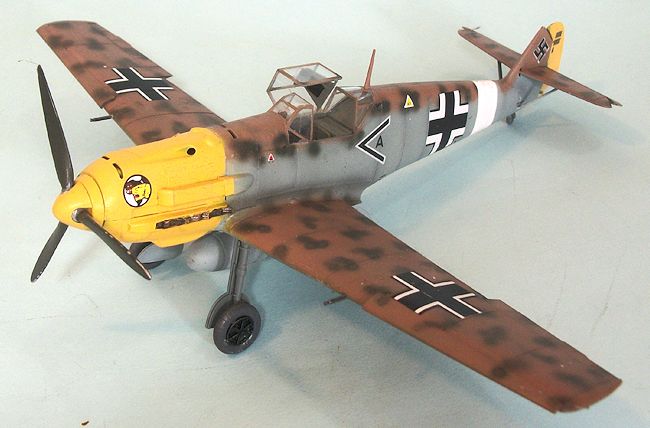 I had
noted that the national insignia were different sized from what I had on
aftermarket sheets, with the upper wing crosses being smaller and the fuselage
crosses being larger. The upper
wing cross was that way to deal with the too-large leading edge slat, but after
fixing that I was able to use a correct-size aftermarket decal.
The fuselage crosses on the kit sheet were too large, while the
aftermarket decals made for Hasegawa and Tamiya kits fit perfectly.
I think this settles the mumbles heard with the series was released that
they were larger than they should be.
The kit swastika decal was also too large and was replaced with an
aftermarket decal that fit perfectly.
I used the personal markings for the airplane depicted on the box top.
I had
noted that the national insignia were different sized from what I had on
aftermarket sheets, with the upper wing crosses being smaller and the fuselage
crosses being larger. The upper
wing cross was that way to deal with the too-large leading edge slat, but after
fixing that I was able to use a correct-size aftermarket decal.
The fuselage crosses on the kit sheet were too large, while the
aftermarket decals made for Hasegawa and Tamiya kits fit perfectly.
I think this settles the mumbles heard with the series was released that
they were larger than they should be.
The kit swastika decal was also too large and was replaced with an
aftermarket decal that fit perfectly.
I used the personal markings for the airplane depicted on the box top.
I gave the model a coat of Xtracrylix Clear Flat varnish, then attached the
landing gear, prop, aileron mass balances and gun barrels.
I kept the airplane clean, so it would appear as it did in photos taken
right after it got its North African camouflage repaint.
I used Tamiya ďSmokeĒ for exhaust stains and under-fuselage oil stains.
The canopy was posed open.
| CONCLUSIONS |
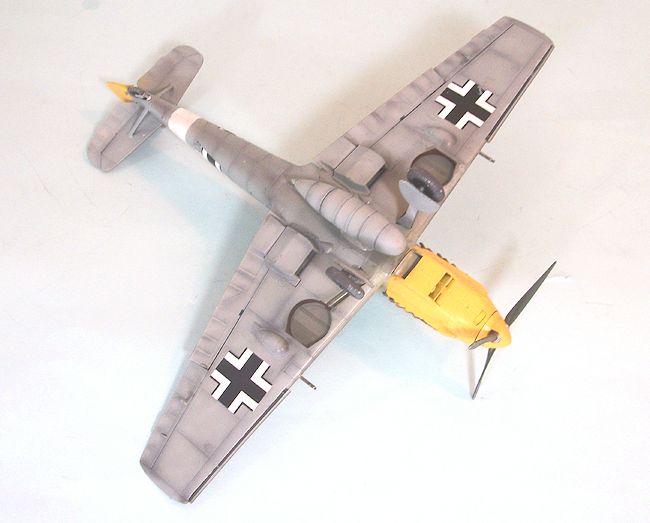 I did not
find that the original complaints the model was some degree of over-scale
accurate, comparing the model to Airfix, Hasegawa and Tamiya Bf-109Es in my
collection. Theyíre all slightly
different in overall dimensions and the Eduard kitís differences are not outside
the other differences.
I did not
find that the original complaints the model was some degree of over-scale
accurate, comparing the model to Airfix, Hasegawa and Tamiya Bf-109Es in my
collection. Theyíre all slightly
different in overall dimensions and the Eduard kitís differences are not outside
the other differences.
Review kit courtesy of HLJ.
If you would like your product reviewed fairly and fairly quickly, please contact the editor or see other details in the Note to Contributors.